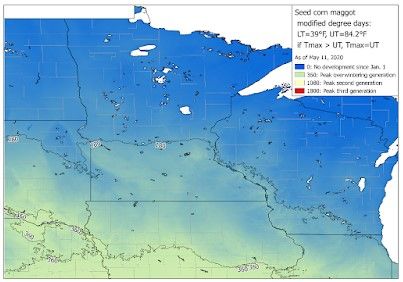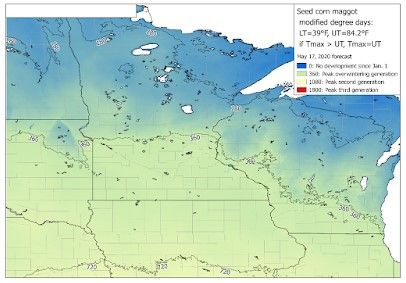By Anthony Hanson
Overlap between how temperatures affect planting timing and pest development frequently affects management decisions, and our warm spring of 2020 is no different in that case.
Seed corn maggot feeds on newly emerging seedlings where adult females lay eggs in disturbed soil beginning in spring, and multiple generations continue throughout the growing season. Infestations are most common in cool wet springs and areas with high organic matter (e.g, manure or recently incorporated plant material). Corn and soybeans are the most economically affected crops, but seed corn maggot has a wide host range on various agronomic and horticultural crops.
To predict pest risk, two questions need to be answered:
- When will the pest show up?
- Will it have sufficient population size to cause significant damage?
Predicting damage timing
The timing of damage occurs in fields planted during the adult population peak for each generation, which can be predicted by calculating degree-days specific to seed corn maggot.
As of May 11, 2020, the overwintering generation peak emergence at 360 degree-days is occuring in central Iowa and is forecast to move through southern Minnesota within the next week as daily average temperatures rebound (Figs. 1 and 2).


Degree-day maps only indicate the time of year when high risk can occur and do not guarantee the seed corn maggot peak population will be large enough to cause economic damage.
This year, the timing of the first generation occurs when much of the corn crop has already been planted in Minnesota and is at reduced risk of infestation. However, the remaining corn and soybean acres to be planted in southern Minnesota during the next week could fall within this window.
For seed corn maggot, answering if it will be at damaging population levels is less exact than predicting timing. Fields with historical seed corn maggot problems or high organic matter should be considered for additional management if they are being planted this week. Our mostly warm and dry spring means many fields across the state are not ideal for seed corn maggot, and no action is needed when adults do show up. However, growers with heavy soil that has been slow to warm or dry out may still have some risk.
After planting, there are no effective treatments once damage occurs, though there are some insecticides labeled for in-furrow or seed-applied use at planting. Planting can also be delayed in high-risk fields until later in May to avoid peak seedcorn maggot flight; this decision also needs to be balanced with the likelihood of seed corn maggot reaching damaging levels in particular field and if it’s economically feasible to wait another week depending on the growing needs of the crop.
Source : umn.edu